Yanyun Qu
SeqVLM: Proposal-Guided Multi-View Sequences Reasoning via VLM for Zero-Shot 3D Visual Grounding
Aug 28, 2025Abstract:3D Visual Grounding (3DVG) aims to localize objects in 3D scenes using natural language descriptions. Although supervised methods achieve higher accuracy in constrained settings, zero-shot 3DVG holds greater promise for real-world applications since eliminating scene-specific training requirements. However, existing zero-shot methods face challenges of spatial-limited reasoning due to reliance on single-view localization, and contextual omissions or detail degradation. To address these issues, we propose SeqVLM, a novel zero-shot 3DVG framework that leverages multi-view real-world scene images with spatial information for target object reasoning. Specifically, SeqVLM first generates 3D instance proposals via a 3D semantic segmentation network and refines them through semantic filtering, retaining only semantic-relevant candidates. A proposal-guided multi-view projection strategy then projects these candidate proposals onto real scene image sequences, preserving spatial relationships and contextual details in the conversion process of 3D point cloud to images. Furthermore, to mitigate VLM computational overload, we implement a dynamic scheduling mechanism that iteratively processes sequances-query prompts, leveraging VLM's cross-modal reasoning capabilities to identify textually specified objects. Experiments on the ScanRefer and Nr3D benchmarks demonstrate state-of-the-art performance, achieving Acc@0.25 scores of 55.6% and 53.2%, surpassing previous zero-shot methods by 4.0% and 5.2%, respectively, which advance 3DVG toward greater generalization and real-world applicability. The code is available at https://github.com/JiawLin/SeqVLM.
UniLDiff: Unlocking the Power of Diffusion Priors for All-in-One Image Restoration
Jul 31, 2025Abstract:All-in-One Image Restoration (AiOIR) has emerged as a promising yet challenging research direction. To address its core challenges, we propose a novel unified image restoration framework based on latent diffusion models (LDMs). Our approach structurally integrates low-quality visual priors into the diffusion process, unlocking the powerful generative capacity of diffusion models for diverse degradations. Specifically, we design a Degradation-Aware Feature Fusion (DAFF) module to enable adaptive handling of diverse degradation types. Furthermore, to mitigate detail loss caused by the high compression and iterative sampling of LDMs, we design a Detail-Aware Expert Module (DAEM) in the decoder to enhance texture and fine-structure recovery. Extensive experiments across multi-task and mixed degradation settings demonstrate that our method consistently achieves state-of-the-art performance, highlighting the practical potential of diffusion priors for unified image restoration. Our code will be released.
One-for-More: Continual Diffusion Model for Anomaly Detection
Feb 27, 2025Abstract:With the rise of generative models, there is a growing interest in unifying all tasks within a generative framework. Anomaly detection methods also fall into this scope and utilize diffusion models to generate or reconstruct normal samples when given arbitrary anomaly images. However, our study found that the diffusion model suffers from severe ``faithfulness hallucination'' and ``catastrophic forgetting'', which can't meet the unpredictable pattern increments. To mitigate the above problems, we propose a continual diffusion model that uses gradient projection to achieve stable continual learning. Gradient projection deploys a regularization on the model updating by modifying the gradient towards the direction protecting the learned knowledge. But as a double-edged sword, it also requires huge memory costs brought by the Markov process. Hence, we propose an iterative singular value decomposition method based on the transitive property of linear representation, which consumes tiny memory and incurs almost no performance loss. Finally, considering the risk of ``over-fitting'' to normal images of the diffusion model, we propose an anomaly-masked network to enhance the condition mechanism of the diffusion model. For continual anomaly detection, ours achieves first place in 17/18 settings on MVTec and VisA. Code is available at https://github.com/FuNz-0/One-for-More
CLIP-FSAC++: Few-Shot Anomaly Classification with Anomaly Descriptor Based on CLIP
Dec 05, 2024



Abstract:Industrial anomaly classification (AC) is an indispensable task in industrial manufacturing, which guarantees quality and safety of various product. To address the scarcity of data in industrial scenarios, lots of few-shot anomaly detection methods emerge recently. In this paper, we propose an effective few-shot anomaly classification (FSAC) framework with one-stage training, dubbed CLIP-FSAC++. Specifically, we introduce a cross-modality interaction module named Anomaly Descriptor following image and text encoders, which enhances the correlation of visual and text embeddings and adapts the representations of CLIP from pre-trained data to target data. In anomaly descriptor, image-to-text cross-attention module is used to obtain image-specific text embeddings and text-to-image cross-attention module is used to obtain text-specific visual embeddings. Then these modality-specific embeddings are used to enhance original representations of CLIP for better matching ability. Comprehensive experiment results are provided for evaluating our method in few-normal shot anomaly classification on VisA and MVTEC-AD for 1, 2, 4 and 8-shot settings. The source codes are at https://github.com/Jay-zzcoder/clip-fsac-pp
Fusion-then-Distillation: Toward Cross-modal Positive Distillation for Domain Adaptive 3D Semantic Segmentation
Oct 25, 2024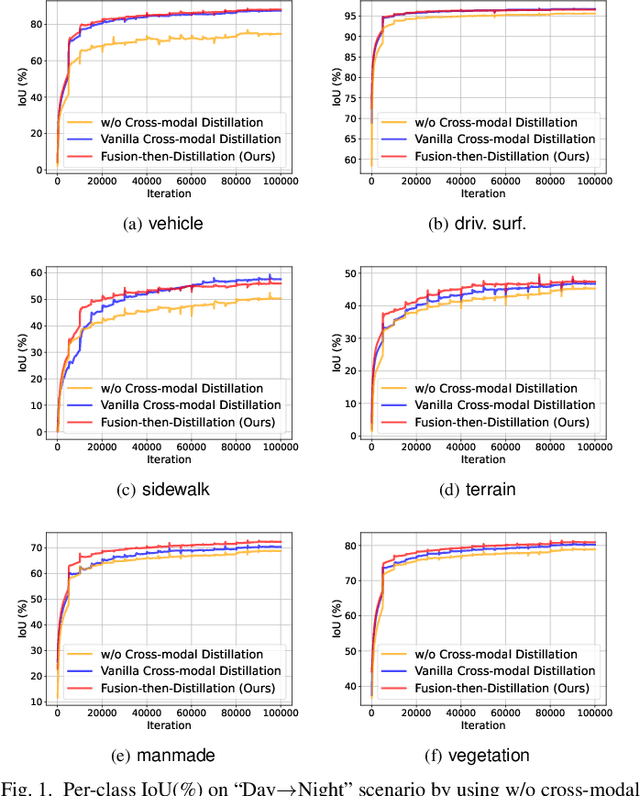
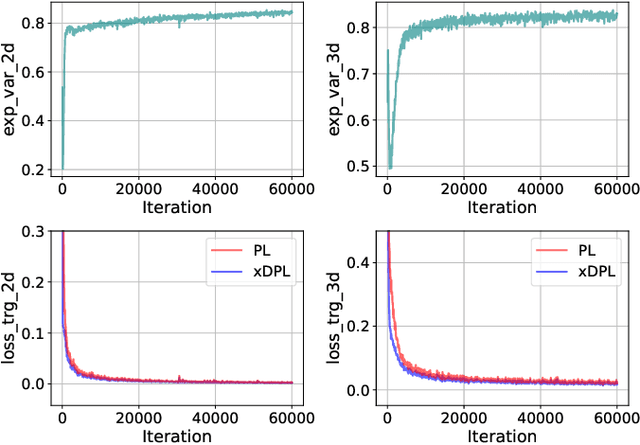
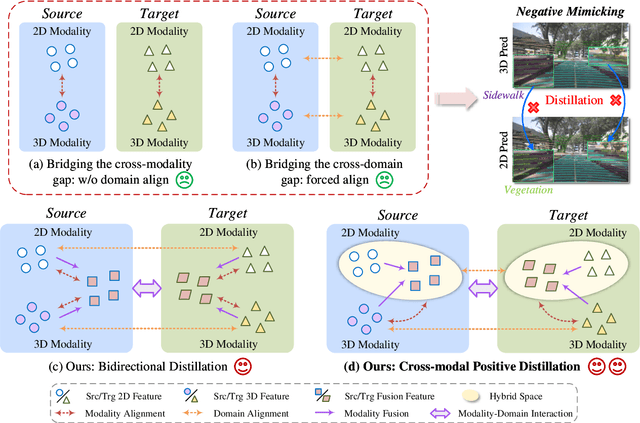
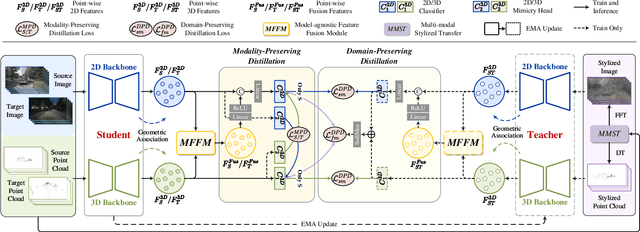
Abstract:In cross-modal unsupervised domain adaptation, a model trained on source-domain data (e.g., synthetic) is adapted to target-domain data (e.g., real-world) without access to target annotation. Previous methods seek to mutually mimic cross-modal outputs in each domain, which enforces a class probability distribution that is agreeable in different domains. However, they overlook the complementarity brought by the heterogeneous fusion in cross-modal learning. In light of this, we propose a novel fusion-then-distillation (FtD++) method to explore cross-modal positive distillation of the source and target domains for 3D semantic segmentation. FtD++ realizes distribution consistency between outputs not only for 2D images and 3D point clouds but also for source-domain and augment-domain. Specially, our method contains three key ingredients. First, we present a model-agnostic feature fusion module to generate the cross-modal fusion representation for establishing a latent space. In this space, two modalities are enforced maximum correlation and complementarity. Second, the proposed cross-modal positive distillation preserves the complete information of multi-modal input and combines the semantic content of the source domain with the style of the target domain, thereby achieving domain-modality alignment. Finally, cross-modal debiased pseudo-labeling is devised to model the uncertainty of pseudo-labels via a self-training manner. Extensive experiments report state-of-the-art results on several domain adaptive scenarios under unsupervised and semi-supervised settings. Code is available at https://github.com/Barcaaaa/FtD-PlusPlus.
LLaCA: Multimodal Large Language Continual Assistant
Oct 08, 2024Abstract:Instruction tuning guides the Multimodal Large Language Models (MLLMs) in aligning different modalities by designing text instructions, which seems to be an essential technique to enhance the capabilities and controllability of foundation models. In this framework, Multimodal Continual Instruction Tuning (MCIT) is adopted to continually instruct MLLMs to follow human intent in sequential datasets. We observe existing gradient update would heavily destroy the tuning performance on previous datasets and the zero-shot ability during continual instruction tuning. Exponential Moving Average (EMA) update policy owns the ability to trace previous parameters, which can aid in decreasing forgetting. However, its stable balance weight cannot deal with the ever-changing datasets, leading to the out-of-balance between plasticity and stability of MLLMs. In this paper, we propose a method called Multimodal Large Language Continual Assistant (LLaCA) to address the challenge. Starting from the trade-off prerequisite and EMA update, we propose the plasticity and stability ideal condition. Based on Taylor expansion in the loss function, we find the optimal balance weight is basically according to the gradient information and previous parameters. We automatically determine the balance weight and significantly improve the performance. Through comprehensive experiments on LLaVA-1.5 in a continual visual-question-answering benchmark, compared with baseline, our approach not only highly improves anti-forgetting ability (with reducing forgetting from 22.67 to 2.68), but also significantly promotes continual tuning performance (with increasing average accuracy from 41.31 to 61.89). Our code will be published soon.
Data-free Distillation with Degradation-prompt Diffusion for Multi-weather Image Restoration
Sep 05, 2024



Abstract:Multi-weather image restoration has witnessed incredible progress, while the increasing model capacity and expensive data acquisition impair its applications in memory-limited devices. Data-free distillation provides an alternative for allowing to learn a lightweight student model from a pre-trained teacher model without relying on the original training data. The existing data-free learning methods mainly optimize the models with the pseudo data generated by GANs or the real data collected from the Internet. However, they inevitably suffer from the problems of unstable training or domain shifts with the original data. In this paper, we propose a novel Data-free Distillation with Degradation-prompt Diffusion framework for multi-weather Image Restoration (D4IR). It replaces GANs with pre-trained diffusion models to avoid model collapse and incorporates a degradation-aware prompt adapter to facilitate content-driven conditional diffusion for generating domain-related images. Specifically, a contrast-based degradation prompt adapter is firstly designed to capture degradation-aware prompts from web-collected degraded images. Then, the collected unpaired clean images are perturbed to latent features of stable diffusion, and conditioned with the degradation-aware prompts to synthesize new domain-related degraded images for knowledge distillation. Experiments illustrate that our proposal achieves comparable performance to the model distilled with original training data, and is even superior to other mainstream unsupervised methods.
Mutual Information Guided Optimal Transport for Unsupervised Visible-Infrared Person Re-identification
Jul 17, 2024



Abstract:Unsupervised visible infrared person re-identification (USVI-ReID) is a challenging retrieval task that aims to retrieve cross-modality pedestrian images without using any label information. In this task, the large cross-modality variance makes it difficult to generate reliable cross-modality labels, and the lack of annotations also provides additional difficulties for learning modality-invariant features. In this paper, we first deduce an optimization objective for unsupervised VI-ReID based on the mutual information between the model's cross-modality input and output. With equivalent derivation, three learning principles, i.e., "Sharpness" (entropy minimization), "Fairness" (uniform label distribution), and "Fitness" (reliable cross-modality matching) are obtained. Under their guidance, we design a loop iterative training strategy alternating between model training and cross-modality matching. In the matching stage, a uniform prior guided optimal transport assignment ("Fitness", "Fairness") is proposed to select matched visible and infrared prototypes. In the training stage, we utilize this matching information to introduce prototype-based contrastive learning for minimizing the intra- and cross-modality entropy ("Sharpness"). Extensive experimental results on benchmarks demonstrate the effectiveness of our method, e.g., 60.6% and 90.3% of Rank-1 accuracy on SYSU-MM01 and RegDB without any annotations.
Exploring the Untouched Sweeps for Conflict-Aware 3D Segmentation Pretraining
Jul 10, 2024



Abstract:LiDAR-camera 3D representation pretraining has shown significant promise for 3D perception tasks and related applications. However, two issues widely exist in this framework: 1) Solely keyframes are used for training. For example, in nuScenes, a substantial quantity of unpaired LiDAR and camera frames remain unutilized, limiting the representation capabilities of the pretrained network. 2) The contrastive loss erroneously distances points and image regions with identical semantics but from different frames, disturbing the semantic consistency of the learned presentations. In this paper, we propose a novel Vision-Foundation-Model-driven sample exploring module to meticulously select LiDAR-Image pairs from unexplored frames, enriching the original training set. We utilized timestamps and the semantic priors from VFMs to identify well-synchronized training pairs and to discover samples with diverse content. Moreover, we design a cross- and intra-modal conflict-aware contrastive loss using the semantic mask labels of VFMs to avoid contrasting semantically similar points and image regions. Our method consistently outperforms existing state-of-the-art pretraining frameworks across three major public autonomous driving datasets: nuScenes, SemanticKITTI, and Waymo on 3D semantic segmentation by +3.0\%, +3.0\%, and +3.3\% in mIoU, respectively. Furthermore, our approach exhibits adaptable generalization to different 3D backbones and typical semantic masks generated by non-VFM models.
CLIP3D-AD: Extending CLIP for 3D Few-Shot Anomaly Detection with Multi-View Images Generation
Jun 27, 2024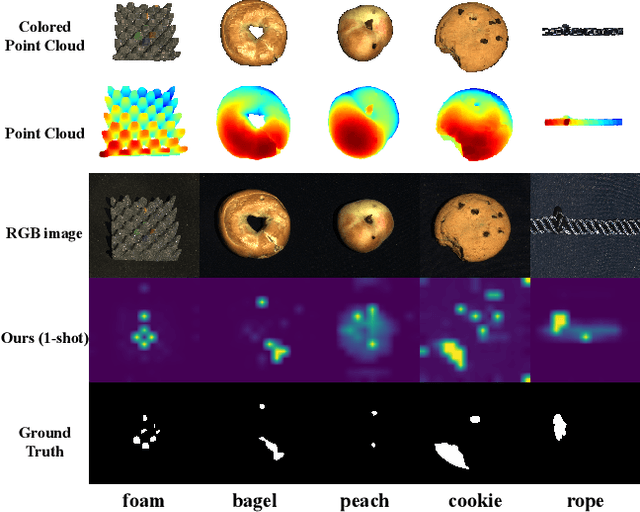
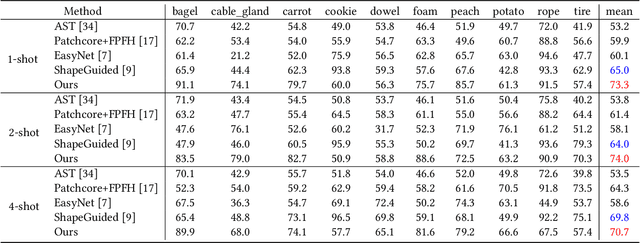
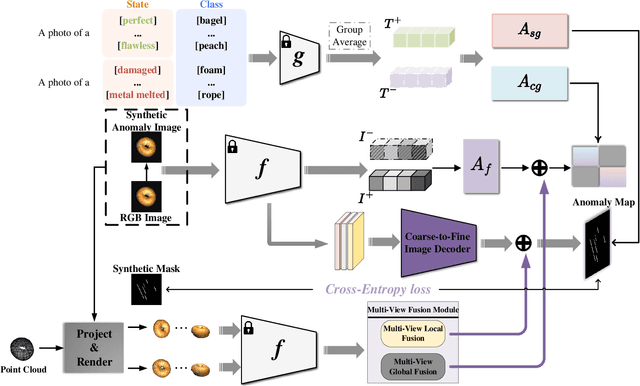
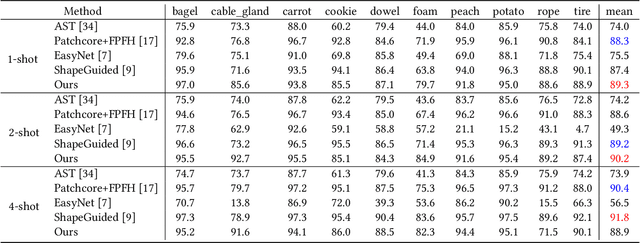
Abstract:Few-shot anomaly detection methods can effectively address data collecting difficulty in industrial scenarios. Compared to 2D few-shot anomaly detection (2D-FSAD), 3D few-shot anomaly detection (3D-FSAD) is still an unexplored but essential task. In this paper, we propose CLIP3D-AD, an efficient 3D-FSAD method extended on CLIP. We successfully transfer strong generalization ability of CLIP into 3D-FSAD. Specifically, we synthesize anomalous images on given normal images as sample pairs to adapt CLIP for 3D anomaly classification and segmentation. For classification, we introduce an image adapter and a text adapter to fine-tune global visual features and text features. Meanwhile, we propose a coarse-to-fine decoder to fuse and facilitate intermediate multi-layer visual representations of CLIP. To benefit from geometry information of point cloud and eliminate modality and data discrepancy when processed by CLIP, we project and render point cloud to multi-view normal and anomalous images. Then we design multi-view fusion module to fuse features of multi-view images extracted by CLIP which are used to facilitate visual representations for further enhancing vision-language correlation. Extensive experiments demonstrate that our method has a competitive performance of 3D few-shot anomaly classification and segmentation on MVTec-3D AD dataset.
 Add to Chrome
Add to Chrome Add to Firefox
Add to Firefox Add to Edge
Add to Edge